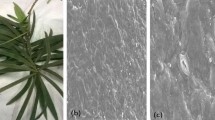Abstract
Urban and peri-urban vegetation is being considered for air pollution abatement. Appropriate plants with efficiency to adsorb and absorb air-pollutants are the prerequisite for green space development. The contributions of surface morphology towards plant’s ability to function as dust particulate adsorber and distribution of trace elements over the leaves are investigated in the present study. Dust interception efficiency was estimated for two roadside plant species named Ficus benghalensis, and Polyalthia longifolia. Leaves of both the plants are capable of capturing dust in the range of 0.12 mg/cm2 to 1.89 mg/cm2 on either of the leaf surfaces. However, variation in dust capturing capacity between the plants was observed. Leaf surface characters such as roughness, length, frequency of trichomes and frequency of stomata played a significant role in capturing re-suspended dust. Frequency (2 to 4 per 0.0004 cm2) and length (152.5 to 92.1 cm) of trichome showed negative co-relation trend, where as frequency and size of stomata showed positive co-relation trend. Elemental analysis by Scanning Electron Microscope attached with Energy Dispersive X-Ray Spectrometer (SEMEDS) indicated the presence of elements such as Sodium (Na), Magnesium (Mg), Aluminium (Al), Silicon (Si), Chlorine (Cl), Pottasium (K), Calcium (Ca), Iron (Fe), Zinc (Zn) and Arsenic (As). The results support the fact that plant canopies can be used for mitigation and bio-monitoring of air pollution as well.





Similar content being viewed by others
References
Aksoy A, Ozturk MA (1997) Nerium oleander L. as biomonitor of lead and other heavy metal pollution in Mediterranean environment. Sci Total Environ 205:145–150
Bache DH (1979) Particle transport within plant canopies—I: a framework for analysis. Atmos Environ 13:1257–1262
Beckett KP, Freer-Smith PH, Taylor G (1998) Urban Woodlands: their role in reducing the effect of particulate pollution. Environ Pollut 99:347–360
Beier C, Gundersen P (1989) Atmospheric deposition to the edge of a Spruce forest in Denmark. Environ Pollut 60:257–271
Borja-Aburto VH, Castellejos M, Gold DR, Bierzwinski S, Loomis D (1998) Mortality and ambient fine particles in southwest Mexico city, 1993–1995. Environ Health Perspect 106:849–855
Chakre OJ (2006) Choice of eco-friendly trees in urban environment to mitigate airborne particulate pollution. J Hum Ecol 20(2):135–138
Das TM, Pattanayak P, Bhaumik A, Ghosh A (2006) Dust filtering property of avenue trees and the effect of air borne particulate matters on growth and yield of paddy plants. Indian Biologist 38:141–148
Datta SC, Ghosh JJ (1985) A study of the distribution pattern of lead in the leaves of banyan trees (Ficus benghalensis) from different traffic density regions of Calcutta. Ecotoxicol Environ Saf 9(1):101–106
Dochinger LS (1980) Interception of airborne particles by tree planting. J Environ Qual 9:265–268
Freer-Smith PH, Hollway S, Goodman A (1997) The uptake of particulates by an urban woodland: site description and particulate composition. Environ Pollut 95(1):27–35
Kar S, Nath B, Samal AC, Santra SC (2006) Arsenic in urban particulates—a case study in Kolkata metropolis. Curr Sci 90(2):158–160
Lohr VI, Pearson-Mims CH (1996) Particulate matter accumulation on horizontal surfaces in interiors: influence of foliage of plants. Atmos Environ 30:2565–2568
Lorenzini G, Grassi C, Nali C, Petiti A, Loppi S, Tognotti L (2006) Leaves of Pittosporum tobira as indicators of airborne trace element and PM10 distribution in central Italy. Atmos Environ 40(22):4025–4036
Meusel I, Neinhuis C, Markstadter C, Barthlott W (1999) Ultrastructure, chemical composition, and recrystallization of epicuticular waxes: transverselyridged roadles. Can J Bot 77:706–720
Neinhuis C, Barthlott W (1998) Seasonal changes of leaf surface contamination in beech, oak and ginkgo in relation to leaf micromorphology and wettability. New Phytol 138:91–98
Nowak DJ, Daniel EC, Stevens JC (2006) Air pollution removal by trees and shrubs in the United States. Urban For Urban Green 4(3–4):115–123
Paulsamy S, Senthilkumar P (2009) Identification of air pollution tolerant tree species for the industrial city, Tirupur, Tamil Nadu. Nat Environ Pollut Technol 8(3):585–588
Prajapati SK, Tripathi BD (2008) Seasonal variation of leaf dust accumulation and pigment content in plant species exposed to urban particulate pollution. J Environ Qual 37:865–870
Prusty BAK, Mishra PC, Azeez PA (2005) Dust accumulation and leaf pigment content in vegetation near the national highway at Sambalpur, Orissa, India. Ecotoxicol Environ Saf 60:228–235
Rossini Oliva S, Rautio P (2004) Could ornamental plants serve as passive bio-monitors in urban areas? J Atmos Chem 49:137–148
Rossini Oliva S, Valdes B (2004) Ligustrum lucidum Ait. F. leaves as a bio-indicator of the air-quality in a Mediterranean city. Environ Monit Assess 96:221–232
Samal AC, Santra SC (2002) Air quality of Kalyani township and its impact on surrounding vegetation. Indian J. Environ. Health 44: 71–76.
Sawidis T, Marnasidis A, Zachariadis G, Stratis J (1995) A study of air pollution with heavy metals in Thessaloniki city (Greece) using trees as biological indicators. Arch Environ Con Tox 28:118–124
Schwartz J, Dockery DW, Neas LM (1996) Is daily mortality associated with fine particles? J Air Waste Manage Assoc 46:927–939
Sudarshan M, Ram SS, Majumdar S, Maity JP, Ray JG, Chakraborty A (2011) Energy-dispersive X-ray fluorescence—a tool for interdisciplinary research. Pramana J Phys 76(2):241–247
Tomasevic M, Vukmirovic Z, Rajsic S, Stevanovic B (2005) Characterization of trace metal particles deposited on some deciduous tree leaves in an urban area. Chemosphere 61:753–760
Virginia IL, Pearson-Mims CH (1995) Particulate matter accumulation on horizontal surfaces in interriors: influence of foliage plants. Atmos Environ 30(14):2565–2568
Wagh ND, Shukla PV, Tambe SB, Ingle ST (2006) Biological monitoring of roadside plants exposed to vehicular pollution in Jalgaon city. J Environ Biol 27(2):419–421
Wiman BLB, Agren GI, Lannefors HO (1985) Aerosol concentration profiles within a mature coniferous forest—model versus field results. Atmos Environ 19:363–367
Wittig R (1993) General aspects of biomonitoring heavy metals by plants. In: Markert B (ed) Plants as biomonitors. Indicators for heavy metals in the terrestrial environment. Verlag Chemie, Weinheim, pp 3–27
Author information
Authors and Affiliations
Corresponding author
Rights and permissions
About this article
Cite this article
Ram, S.S., Majumder, S., Chaudhuri, P. et al. Plant canopies: bio-monitor and trap for re-suspended dust particulates contaminated with heavy metals. Mitig Adapt Strateg Glob Change 19, 499–508 (2014). https://doi.org/10.1007/s11027-012-9445-8
Received:
Accepted:
Published:
Issue Date:
DOI: https://doi.org/10.1007/s11027-012-9445-8




